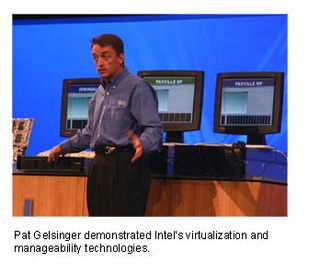Intel's AMT and VT ready for launch
San Francisco (CA) - Intel is about to introduce the next set of additional features for its processors. VT or virtualization technology and AMT or Active Management Technology are designed to initially enhance the usability of the firm's server and workstation processors and will debut in during the third and fourth quarter of this year.
Intel typically uses its IDF conference to send out key messages to its audience on what technologies to expect not only in the long term, but also in the immediate future. In spring of this year, the company urged programmers to begin writing 64-bit applications, which apparently was well received and Intel did not feel a need to repeat this message this time around. Instead, the focus was on the two new features AMT and VT, which will be added to the business and server platforms later this year and early in 2006. It's time to take advantage of these new functionalities, senior vice president Pat Gelsinger, told the audience at the event currently held in San Francisco.

AMT will debut during the third quarter in he Pentium D 800 and Pentium 4 600 series, with Yonah, Pentium D 900, Dempsey and Paxville following in the first quarter of 2006. Montecito will not be available with AMT in the foreseeable time, according to roadmaps seen by Tom's Hardware Guide. Pat Gelsinger described AMT as a tool that can put a "virtual CIO" into silicon and provide a virtual system administrator to every machine. The technology will allow automated maintenance, software uploads, virus removals, even if the system is turned off. Cisco will support Intel in marketing the technology and making software solutions for AMT available.
Stay on the Cutting Edge
Join the experts who read Tom's Hardware for the inside track on enthusiast PC tech news — and have for over 25 years. We'll send breaking news and in-depth reviews of CPUs, GPUs, AI, maker hardware and more straight to your inbox.
Most Popular


